-

新人教版高中英语必修3Unit 1 Festivals and Celebrations-Reading for Writing教学设计一
The topic of this part is “Write about your festival experience”.During the Listening and Speaking and Talking, students are just asked to say out their festival experiences such as the Spring Festival, Mid-autumn Day, but this part students will be asked to write down their own festival experiences. During the reading part, it introduces the Naadam Festival in Inner Mongolia Autonomous Region, which can give students a good example to imitate. Students not only learn the festival, but touch and feel the Inner Mongolian’s character, the spirit and cultural atmosphere, which can help students form the cultural awareness and learn to enjoy and value the diversity of Chinese culture.Concretely, the dairy tells the experience that the author spent the Naadam Festival in Inner Mongolia Autonomous Region with his/her friend. The structure is clear. In the opening paragraph, it introduces the topic of the Naadam Festival and the whole feeling. Then it introduces the items of the festival like the ceremony, wrestling and horse racing. Finally, it summarizes this experience. Because this part is a travel journal, we must guide students pay more attention to these details: 1. use the first person. 2. use the past tense to tell the past thing and use the present or future tense to describe the scenery. 3. use the timeline to tell the development. 4. be careful for the author’s psychology, emotion and feeling, etc.1. Read quickly to get main idea; read carefully to get the detailed information about Naadam Festival.2. Learn the structure of the reading article and language.3. Write an article about a festival experience4. Learn to use the psychology, emotions and feeling in the writing.1. Write an article about a festival experience.2. Use the structure of the reading article and language.

新人教版高中英语必修3Unit 3 Diverse Cultures-Discovering Useful Structure教学设计
Step 4 PracticeRead the conversation. Find out which words have been left out.Justin: Linlin, I’m going to Guizhou Province next month. I’m super excited! Any recommendations for places to visit?Linlin: Wow, cool! Guizhou is a province with a lot of cultural diversity. Places to visit...well, definitely the Huangguoshu Waterfall first.Justin: What’s special about the waterfall?Linlin: Well, have you ever heard of the Chinese novel Journey to the West ?Justin: Yes, I have. Why ?Linlin: In the back of the waterfall, you will find a cave, which is the home of the Monkey King.Justin: Really? Cool! I’ll definitely check it out.Linlin:And I strongly recommend the ethnic minority villages. You’ll find Chinese culture is much more diverse than you thought.Justin:Sounds great, thanks.Answers:Justin: Linlin, I’m going to Guizhou Province next month. I’m super excited! Do you have any recommendations for places to visit?Linlin: Wow, that’s cool! Guizhou is a province with a lot of cultural diversity. What are some places to visit in Guizhou ? Well, definitely the Huangguoshu Waterfall is the first place to visit in Guizhou Province.Justin: What’s special about the waterfall?Linlin: Well, have you ever heard of the Chinese novel Journey to the West ?Justin: Yes, I have heard of the Chinese novel Journey to the West . Why do you ask if I have heard of the Chinese novel Journey to the West?Linlin: In the back of the waterfall, you will find a cave, which is the home of the Monkey King from Journey to the West.Justin: That’s really true? It’s Cool! I’ll definitely check it out.Linlin:And I strongly recommend the ethnic minority villages on your trip to Guizhou Province. You’ll find Chinese culture is much more diverse than you thought it was.Justin:This all sounds great, thanks.

新人教版高中英语必修3Unit 4 Space Exploration-Listening&Speaking&Talking教学设计一
Listening and Speaking introduces the topic of “talking about how to become an astronaut”. This period is aimed to inform students some details about the requirements of being an astronaut. Students can be motivated and inspired by the astronauts. Teachers ought to encourage students to learn from them and let them aim high and dream big.Listening and Talking introduces the theme of "talk about life in space". This part also informs students more details about life in space and can inspire students to be curious about this job. 1. Guide students to listen for numbers concerning dates, years and ages etc2. Cultivate students' ability to talk about how to become an astronaut and life in space ; 3. Instruct students to use functional sentences of the dialogue such as “ first of all, I am not sure, so what might be .. I guess.. I wonder…I am curious…)appropriately.1. Guide students to understand the content of listening texts in terms of the whole and key details; 2. Cultivate students' ability to guess the meaning of words in listening; discuss with their peers how to become a qualified astronaut and describe the life in space.Part 1: Listening and SpeakingStep 1: Lead inPredictionThe teacher can ask students to predict what the listening text is about by looking at the pictures.About how to become an astronaut./the requirements of an astronautStep 2: Then, play the radio which is about an interview a. And after finishing listening for the first time, the students need to solve the following tasks.

新人教版高中英语必修3Unit 4 Space Exploration-Discovering Useful Structure教学设计
The theme of the section is “Describe space facts and efforts to explore space”. Infinitives are one of non-finite verbs, as the subjects, objects, predicative, attributes and adverbials. This unit is about space exploration, which is a significant scientific activity, so every scientific activity has strong planning. Therefore, using the infinitives to show its purpose, explanations or restrictions is the best choice.1. Learn the structure, functions and features of infinitives.2. Learn to summarize some rules about infinitives to show purpose and modify.3. Learn to use infinitives in oral and writing English. 1. Learn the structure, functions and features of infinitives.2. Learn to summarize some rules about infinitives to show purpose and modify.3. Learn to use use infinitives in oral and writing English.Step 1 Lead in---Pair workLook at the following sentences and focus on the italicized infinitives. In pairs, discuss their functions. 1. I trained for a long time to fly airplanes as a fighter pilot..(作目的状语)2. As we all know, an astronaut needs to be healthy and calm in order to work in space..(作目的状语)3. First of all, you must be intelligent enough to get a related college degree..(作目的状语)4. Some scientist were determined to help humans realise their dream to explore space..(作定语)5. On 12 April 1961, Yuri Gagarin became the first person in the world to go into space..(作定语)Summary:1. 不定式的结构:to+do原形。2. 分析上面的句子,我们知道在描述太空探索时,动词不定式不仅可以用来表目的,还可以用来作定语,表修饰。
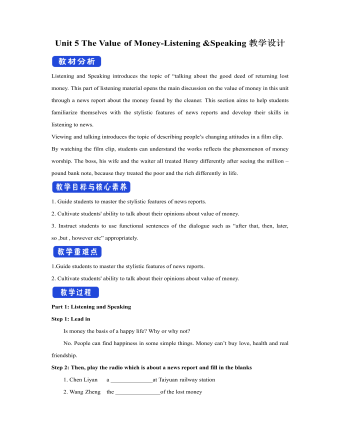
新人教版高中英语必修3Unit 5 The Value of Money-Listening &Speaking教学设计
Step 4: Listen again and decide if the following statements are true (T) or false (F).1 It was the first time Chen Liyan's story was reported. T口 F口2 Chen found 10,000 yuan in a small plastic bag in Taiyuan railway station口 F口3 Wang Zheng apologized to Chen because he couldn't offer her more money. T口 F口4 Chen took out a large loan to cure her daughter, T口 F口5 Wang set up a fundraising website for Chen's daughter after Chen told him about her situation. T口 F口Step 5:After listening, discuss the questions.1 What kind of person do you think Chen Liyan is?Chen Liyan is generous and honest because she returned a large sum of money to the owner.2 Did Chen return the money because she didn't need it?No. She returned the money because it was the right thing to do. Evidence for this is that she refused to accept the reward money because she felt that it had not been earned. 3 Is it common for people to do what Chen did?It depends on the culture. In some countries it is quite common to return money that has been found. In other countries, people believe "Finders are keepers!" 4 How did Wang Zheng feel about the return of his money?He must have been very happy and relieved to have gotten his money back. We know this because he thanked Chen repeatedly and even offered her a reward.5 Why did Ma Dongbao tell Wang about Chen's family?He must have had great sympathy for Chen and her daughter and wanted to help them.'We know this because he arranged help for them. 6 How did the news reporter feel about Chen's actions?The news reporter felt that it showed that money wasn't the most important thing in life. We know this because the reporter told us that this is what Chen believes. and then said, “that's a great attitude to take."
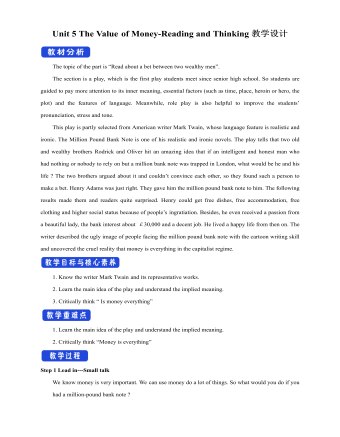
新人教版高中英语必修3Unit 5 The Value of Money-Reading and Thinking教学设计一
Everybody wants to get wealth.In today’s material world,making money or becoming wealthy symbolizes a person’s success and capability. Many people just make every effort, pay any price to attain greater wealth. With money,they can buy nice, large apartments in nice neighborhood. With money they can own luxurious cars. Wealth seems to bring all happiness in life.But is wealth the only road to happiness? Not really. There are many things in the world, which are beyond the means of money, such as friendship, love, health and knowledge. People are so preoccupied with struggling for money that they have no time or would not take the time to form or maintain friendship. What happiness can they feel living as lonely miserable creatures without love or friends in the world even if they accumulate tremendous wealth?In my opinion, people can’t do anything without money, but money is not everything. What money will bring you depends on your personal belief and goal in life. If you are kind enough to help others, especially the poor, money is a good thing to you. With it, you can do much more for the benefit of people and your country, and it will add to your own happiness. If you want money just for your own needs, you’ll never be satisfied or happy. In a word,you should have money spent for more people. Only then can money be the source of your happiness.Step 8 Homework4 students in a group, one acts Roderick, one Oliver, one servant and the fourth one acts Henry Adams, then listen to the tape, pay more attention to the difference between American English and British English in pronunciation, stress, tone.
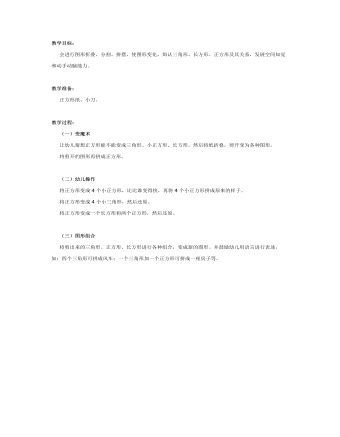
中班数学教案:会变的图形
教学准备: 正方形纸、小刀。 教学过程: (一)变魔术 让幼儿猜想正方形能不能变成三角形、小正方形、长方形。然后将纸折叠,剪开变为各种图形。 将剪开的图形再拼成正方形。
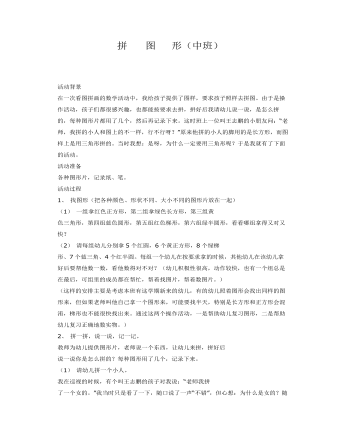
中班数学:拼图形课件教案
活动准备各种图形片,记录纸、笔。活动过程1、找图形(把各种颜色、形状不同、大小不同的图形片放在一起)(1)一组拿红色正方形,第二组拿绿色长方形,第三组黄色三角形,第四组蓝色圆形,第五组红色梯形,第六组绿半圆形,看看哪组拿得又对又快?(2)请每组幼儿分别拿5个红圆,6个黄正方形,8个绿梯形、7个蓝三角、4个红半圆。每组一个幼儿在按要求拿的时候,其他幼儿在该幼儿拿好后要帮他数一数,看他数得对不对?(幼儿积极性很高,动作较快,也有一个组总是在最后,可组里的成员都在帮忙,帮着找图片,帮着数图片。)(这样的安排主要是考虑本班有这学期新来的幼儿,有的幼儿照着图形会找出同样的图形来,但如果老师叫他自己拿一个图形来,可能要找半天,特别是长方形和正方形会混洧,梯形也不能很快找出来。通过这两个操作活动,一是帮助幼儿复习图形,二是帮助幼儿复习正确地数实物。)2、拼一拼,说一说,记一记。教师为幼儿提供图形片,老师说一个东西,让幼儿来拼,拼好后说一说你是怎么拼的?每种图形用了几个,记录下来。(1)请幼儿拼一个小人。我在巡视的时候,有个叫王志鹏的孩子对我说:“老师我拼了一个女的。”我当时只是看了一下,随口说了一声“不错”,但心想:为什么是女的?随后又去看其他幼儿拼的情况,这时由于受王志鹏小朋友的启发,我注意看其他孩子的,发现了孩子们拼的小人各有不同,全班只有几个孩子和别人拼的是一样的,其他都不相同。拼好后,我就先请王志鹏说一说,他是怎么拼的?王志鹏说:“我用圆形拼了这个女孩子的头,用正方形拼了她的身体,用长方形拼了她的手,用梯形拼了她的裙子……”张洁说:“我也拼了一个女孩子,是圆形拼了她的头,三角形拼了她的手和身体,梯形拼了她的裙子,腿被裙子挡住了。”也有好多是拼的女孩子,但他们不是体现在裙子上,而是体现在头上,如赵磊用两个半圆拼女孩子的辫子,冠晔是用两个圆拼了辫子……(就拼一个小人,幼儿就用不同的图形拼出了不同的女孩子而且每个孩子都能把自己拼的过程,用自己的语言表述出来。如果孩子不说给你听,你可能粗看一下还不能明白,但经孩子这么一讲解,当时真是恍然大悟,正如瑞吉欧所说:孩子有一百种语言,一百双手,一百个念头,一百种思考、游戏、说话的方式。)
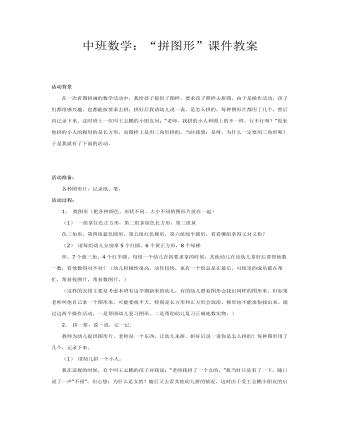
中班数学:“拼图形”课件教案
活动准备: 各种图形片,记录纸、笔。活动过程:1、找图形(把各种颜色、形状不同、大小不同的图形片放在一起) (1)一组拿红色正方形,第二组拿绿色长方形,第三组黄 色三角形,第四组蓝色圆形,第五组红色梯形,第六组绿半圆形,看看哪组拿得又对又快? (2)请每组幼儿分别拿5个红圆,6个黄正方形,8个绿梯 形、7个蓝三角、4个红半圆。每组一个幼儿在按要求拿的时候,其他幼儿在该幼儿拿好后要帮他数一数,看他数得对不对?(幼儿积极性很高,动作较快,也有一个组总是在最后,可组里的成员都在帮忙,帮着找图片,帮着数图片。) (这样的安排主要是考虑本班有这学期新来的幼儿,有的幼儿照着图形会找出同样的图形来,但如果老师叫他自己拿一个图形来,可能要找半天,特别是长方形和正方形会混洧,梯形也不能很快找出来。通过这两个操作活动,一是帮助幼儿复习图形,二是帮助幼儿复习正确地数实物。)
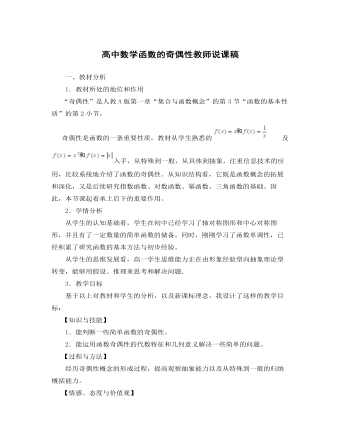
高中数学函数的奇偶性教师说课稿
2.学情分析从学生的认知基础看,学生在初中已经学习了轴对称图形和中心对称图形,并且有了一定数量的简单函数的储备。同时,刚刚学习了函数单调性,已经积累了研究函数的基本方法与初步经验。从学生的思维发展看,高一学生思维能力正在由形象经验型向抽象理论型转变,能够用假设、推理来思考和解决问题.
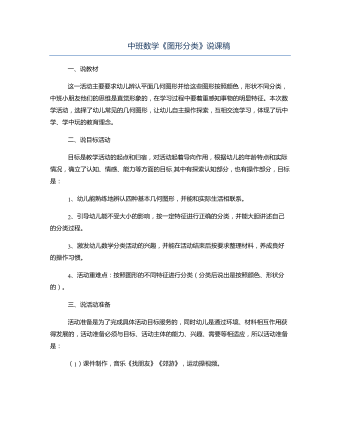
中班数学《图形分类》说课稿
1、创设情境、激发幼儿参与活动的兴趣兴趣是最好的老师。通过律动运动操引起幼儿上课的兴趣,吸引他们的注意力,激发他们参与活动的兴趣。引导学生回忆已经学过的图形,借机引出课题,交代学习目标。2、合作交流,探究新知(1)梳理思路,展示过程。教师用电子白板演示分类的过程,加深学生对图形分类的认识。(2)幼儿分组尝试分类提出分类问题之后,让幼儿先思考一下如何分类,在独立思考的基础上再让幼儿借助学具分小组动手分一分,说一说。(3)运用拓展,课外延伸出示拼图,启发幼儿用几何图形自由快乐拼图。引导他们思考问题,寻求解决问题的办法,相互交流帮助,分享探索的过程和结果。从而得出结论--用几个不同形状的图形能拼出一个新的图形来。幼儿在游戏过程中反复感受、反复体验以突破难点。同时也培养孩子初步的合作意识和能力。
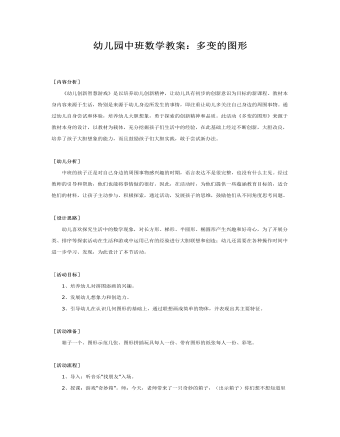
幼儿园中班数学教案:多变的图形
[幼儿分析] 中班的孩子正是对自己身边的周围事物感兴趣的时期,语言表达不是很完整,也没有什么主见。经过教师的引导和帮助,他们也能将事情做的很好。因此,在活动时,为他们提供一些蕴涵教育目标的,适合他们的材料,让孩子主动参与、积极探索,通过活动,发展孩子的思维,鼓励他们从不同角度思考问题。 [设计思路] 幼儿喜欢探究生活中的数学现象,对长方形、梯形、半圆形、椭圆形产生兴趣和好奇心,为了开展分类、排序等探索活动在生活和游戏中运用已有的经验进行大胆联想和创造;幼儿还需要在各种操作时间中进一步学习、发现,为此设计了本节活动。 [活动目标]1、培养幼儿对拼图添画的兴趣。2、发展幼儿想象力和创造力。3、引导幼儿在认识几何图形的基础上,通过联想画成简单的物体,并表现出其主要特征。
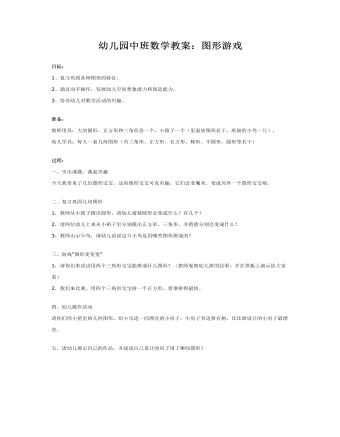
幼儿园中班数学教案:图形游戏
2、通过动手操作,发展幼儿空间想象能力和创造能力。 3、培养幼儿对数学活动的兴趣。准备: 教师用具:大的圆形、正方形和三角形各一个,小箱子一个(里面放图形若干,纸做的小鸟一只), 幼儿学具:每人一套几何图形(有三角形、正方形、长方形、梯形、半圆形,圆形等若干)过程:一、引出课题,激起兴趣 今天我带来了几位图形宝宝,这些图形宝宝可真有趣,它们会变魔术,变成另外一个图形宝宝呢。
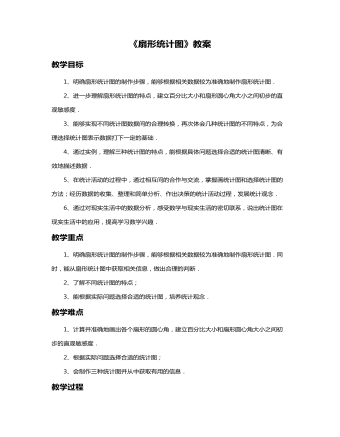
扇形统计图教案教学设计
教学目标1、明确扇形统计图的制作步骤,能够根据相关数据较为准确地制作扇形统计图.2、进一步理解扇形统计图的特点,建立百分比大小和扇形圆心角大小之间初步的直观敏感度.3、能够实现不同统计图数据间的合理转换,再次体会几种统计图的不同特点,为合理选择统计图表示数据打下一定的基础.4、通过实例,理解三种统计图的特点,能根据具体问题选择合适的统计图清晰、有效地描述数据.5、在统计活动的过程中,通过相互间的合作与交流,掌握画统计图和选择统计图的方法;经历数据的收集、整理和简单分析、作出决策的统计活动过程,发展统计观念.6、通过对现实生活中的数据分析,感受数学与现实生活的密切联系,说出统计图在现实生活中的应用,提高学习数学兴趣.
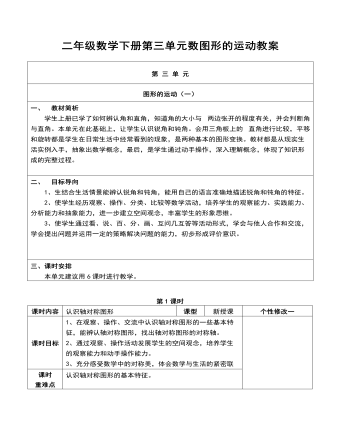
二年级数学下册第三单元数图形的运动教案
一、游戏活动激趣,认识对称物体1、游戏“猜一猜”:课件依次出示“剪刀、扫帚、飞机、梳子”的一部分,分男、女生猜。2、认识对称物体:1)师质疑:为什么女生猜得又快又准呢?2)小结:像这样两边形状、大小都完全相同的物体,我们就说它是对称物体。(板书:对称)二、猜想验证新知,认识轴对称图形(一)初步感知对称图形1、将“剪刀、飞机、扇子”等对称物体抽象出平面图形,让学生观察,这些平面图形还是不是对称的。2、师小结:像这样的图形,叫做对称图形。(板书:图形)(二)猜想验证对称图形1、猜一猜:出示“梯形、平行四边形、圆形、燕尾箭头”等平面图形,让学生观察。师:这些平面图形是不是对称图形?怎样证明它们是不是对称图形?
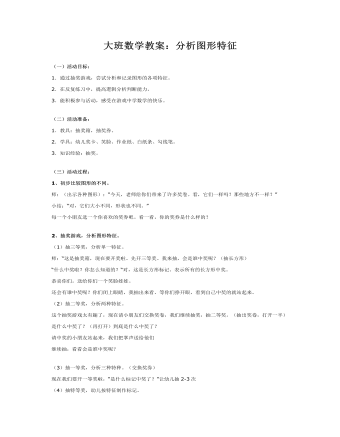
大班数学教案:分析图形特征
(二)活动准备: 1.教具:抽奖箱,抽奖券。 2.学具:幼儿奖卡、笑脸、作业纸、白纸条、勾线笔。 3.知识经验:抽奖。 (三)活动过程: 1、初步比较图形的不同。 师:(出示各种图形):“今天,老师给你们带来了许多奖卷。看,它们一样吗?那些地方不一样?” 小结:“对,它们大小不同,形状也不同。” 每一个小朋友选一个你喜欢的奖券吧。看一看,你的奖券是什么样的? 2、抽奖游戏,分析图形特征。 (1)抽三等奖,分析单一特征。 师:“这是抽奖箱,现在要开奖啦。先开三等奖。我来抽,会是谁中奖呢?(抽长方形) “什么中奖啦?你怎么知道的?“对,这是长方形标记。表示所有的长方形中奖。 恭喜你们。送给你们一个笑脸娃娃。 还会有谁中奖呢?你们闭上眼睛,我抽出来看。等你们挣开眼,看到自己中奖的就站起来。
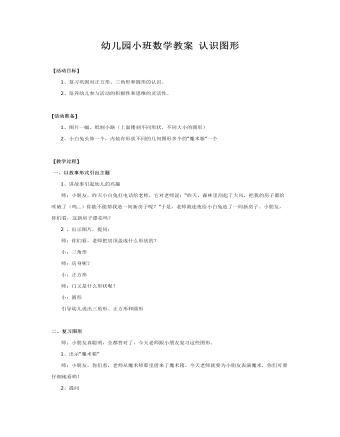
幼儿园小班数学教案 认识图形
[活动准备] 1、图片一幅、纸制小路(上面镂刻不同形状、不同大小的图形) 2、小白兔头饰一个,内装有形状不同的几何图形多个的“魔术箱”一个 [教学过程] 一、以故事形式引出主题 1、讲故事引起幼儿的兴趣 师:小朋友,昨天小白兔打电话给老师,它对老师说:“昨天,森林里刮起了大风,把我的房子都给吹破了(呜…)你能不能帮我造一间新房子呢?”于是,老师就连夜给小白兔造了一间新房子。小朋友,你们看,这新房子漂亮吗? 2 、出示图片,提问: 师:你们看,老师把房顶盖成什么形状的? 小:三角形 师:房身呢? 小:正方形 师:门又是什么形状呢? 小:圆形 引导幼儿说出三角形、正方形和圆形
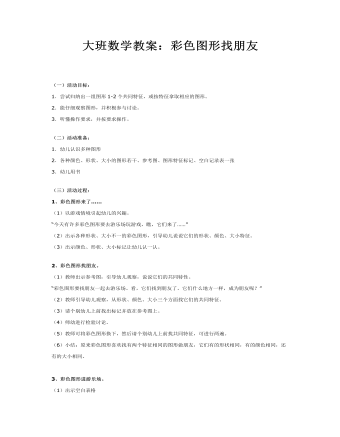
大班数学教案:彩色图形找朋友
2.能仔细观察图形,并积极参与讨论。 3.听懂操作要求,并按要求操作。 (二)活动准备: 1.幼儿认识多种图形 2.各种颜色、形状、大小的图形若干、参考图、图形特征标记、空白记录表一张 3.幼儿用书(三)活动过程: 1、彩色图形来了…… (1)以游戏情境引起幼儿的兴趣。 “今天有许多彩色图形要去游乐场玩游戏,瞧,它们来了……” (2)出示各种形状、大小不一的彩色图形,引导幼儿说说它们的形状、颜色、大小特征。 (3)出示颜色、形状、大小标记让幼儿认一认。

大班数学教案:图形宝宝找家
二、活动准备 画有“〈”“〉”符号卡片两张、1—10数字卡一套、苹果卡片三张、桃子卡片两张、粉笔三支、铅笔一支、练习题每人三张。 三、活动过程 (一) 引出主题,认识大于号 “>” 和小于号 “<”。 1. 教师边出示 “>” 和 “<” 的卡片,边说:“今天老师带来两个好伙伴给你们认识,你们认识他们吗?” 2. 教师出示大于号 “>” (1) 教师:它叫大于号,开口向左,跟着老师念:大于号,开口向着大数笑。 (2) 教师举例,在黑板上写出3 >1,读作三大于一,跟着老师再念一遍,大于号,开口向着大数笑。 3. 教师出示小于号 “<” (1) 教师:它叫小于号,开口向右,跟着老师念:小于号,尾巴对着小数翘。 (2) 教师举例:在黑板上写出2<4,读作二小于四,跟着老师再念一遍,小于号,尾巴对着小数翘。
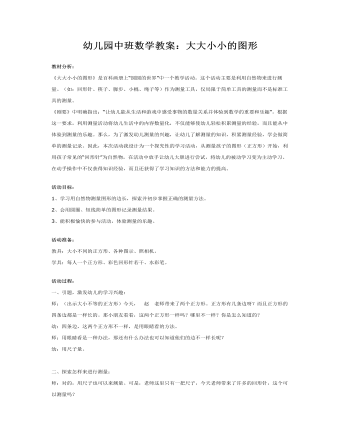
幼儿园中班数学教案:大大小小的图形
《刚要》中明确指出:“让幼儿能从生活和游戏中感受事物的数量关系并体验到数学的重要和乐趣”。根据这一要求,利用测量活动将幼儿生活中的内容数量化,不仅能够使幼儿轻松积累测量的经验,而且能从中体验到测量的乐趣。那么,为了激发幼儿测量的兴趣,让幼儿了解测量的知识,积累测量经验,学会做简单的测量记录。因此,本次活动我设计为一个探究性的学习活动,从测量孩子的图形(正方形)开始,利用孩子常见的“回形针”为自然物,在活动中放手让幼儿大胆进行尝试,将幼儿的被动学习变为主动学习。在动手操作中不仅获得知识经验,而且还获得了学习知识的方法和能力的提高。 活动目标: 1、学习用自然物测量图形的边长,探索并初步掌握正确的测量方法。 2、会用圆圈、短线简单的图形记录测量结果。 3、能积极愉快的参与活动,体验测量的乐趣。 活动准备: 教具:大小不同的正方形、各种图示、照相机。 学具:每人一个正方形、彩色回形针若干、水彩笔。

